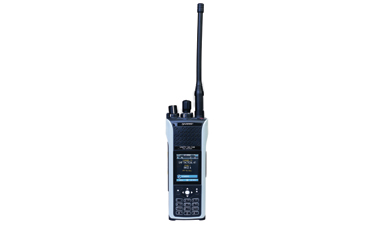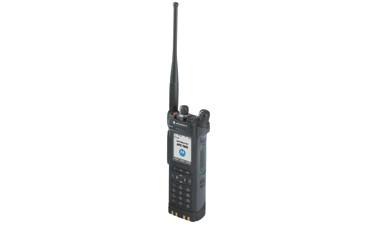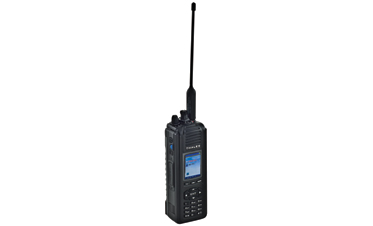Cool Cache: Mobile/portable
In 2008, multiband hit the public safety communications market. Within months of each other, Harris RF, Motorola and Thales released handheld multiband radios designed to communicate across VHF, UHF, 700 MHz and 800 MHz bands. This technology is truly innovative and designed to advance interoperable communications between all agencies in all bands. Here is the latest news about these 2008Public Safety CommunicationsHot Products:
 Harris RF Unity XG-100:Introduced in July 2008, the Unity XG-100 from Harris Corp is a full-spectrum multiband portable radio for the public safety market. The radio is compliant with the APCO Project 25 technical standard in both conventional and trunking modes and is approximately the same size as currently fielded single-banded radios. It measures 2.5 x 6.5 x 1.8 inches and weighs 19 oz.
Harris RF Unity XG-100:Introduced in July 2008, the Unity XG-100 from Harris Corp is a full-spectrum multiband portable radio for the public safety market. The radio is compliant with the APCO Project 25 technical standard in both conventional and trunking modes and is approximately the same size as currently fielded single-banded radios. It measures 2.5 x 6.5 x 1.8 inches and weighs 19 oz.
The radio offers a 16 channel selector and has a storage capacity of 12,500 channels. Unity XG-100 also has dual microphones for built-in noise reduction and provides clear audio in high-noise environments. Other specs include Bluetooth, P25 OTAR, AES/DES encryption, 12-hour battery life and radio-to-radio wireless cloning. At the IACP conference in October, Harris demonstrated the radio’s noise suppression feature via a sound booth and 90 decibels of music. When the mic was keyed, attendees could hear the user clearly and not the background noise.
Harris has recently expanded its interoperability offerings by combining the Unity product suite with its VIDA Network platform, creating a complete end-to-end, IP-based solution. At press time, the FCC was considering the Unity XG-100 for FCC type-acceptance.
Motorola’s APX:In August, Motorola began shipping the APXTM 7000 two-way radio, a Project 25 multiband (700/800 MHz and VHF) handheld. The APX designed to  communicate with current and future P25 networks (FDMA and TDMA) and has integrated GPS. It’s 6.55 x 2.98 x 1.65 inches and weighs 18.4 oz. The radio also offers eight hours of battery life.
communicate with current and future P25 networks (FDMA and TDMA) and has integrated GPS. It’s 6.55 x 2.98 x 1.65 inches and weighs 18.4 oz. The radio also offers eight hours of battery life.
In the field:Nebraska is working with Motorola to build a statewide radio network, the Nebraska Wireless Interoperable Network (N.WIN). On Sept. 23, Nebraska Gov. Dave Heineman announced the launch of the network’s first phase. For the Nebraska State Patrol, the system includes the APX radio, allowing it to connect with local first responders in the state’s 93 counties and other state agencies. The Nebraska State Fire Marshall’s Office is also buying APX radios.
State Patrol Project Manager David Babcock says, “In order to get radio coverage independent of a vehicle repeater, we needed a portable radio with VHF and 800 MHz frequencies. We also wanted to get better interoperability, and we knew officers would be able to talk to a lot more local agencies with the APX.
“We recongnized that the APX had advantages other than just multiband,” Babcock continues. “It offers more volume, clarity and better noise canceling characteristics than the other radios we considered [during the RFP process].”
Approximately 60 radios have been purchased and distributed to officers in Nebraska State Patrol’s Troop E and another 100 have been ordered. Because the network is in its infancy, officers have only been able to complete initial field testing on the APX due to the lack of infrastructure. At press time, the statewide system was scheduled for completion by the end of 2010.
“The officers have been very impressed with the APX in particular; and they are very anxious to start using them,” Babcock says.
 Thales’ Liberty:Released in early 2008, the Liberty Multiband land mobile radio from Thales Communications Inc. is a software-defined radio solution designed to work across all U.S. public safety bands. On April 22, the Liberty received FCC certification and, at press time, was the only FCC-type accepted multiband handheld available for the public safety market.
Thales’ Liberty:Released in early 2008, the Liberty Multiband land mobile radio from Thales Communications Inc. is a software-defined radio solution designed to work across all U.S. public safety bands. On April 22, the Liberty received FCC certification and, at press time, was the only FCC-type accepted multiband handheld available for the public safety market.
In July, the Department of Homeland security selected 14 organizations to pilot test the Liberty and multiband technology. Agencies participating in the testing include FEMA, the Boise Fire Department, Michigan Emergency Medical Services, the Phoenix Police Department and the Arizona Department of Emergency Management. Each agency was scheduled to conduct a minimum 30-day pilot focusing on the capabilities and effectiveness of the technology. The results of the tests are scheduled for publication in early 2010 via the SAFECOM program Web site.
The Boise Fire Department is participating in the DHS testing and has been providing Thales with end-user feedback. It was hoping to determine if multiband technology would be a functional public safety tool.
In early 2009, the department used the Liberty during a controlled burn. Four radios were on scene: two officers had radios on the fire lines during interior firefighting operations, and both the Incident Commander and Safety Officer had a Liberty. Although they were not able to test the multiband feature, Boise Fire Department Capt. Paul Roberts says, “The audio was good for both receiving and transmitting. The general consensus from the line officers was that it is bigger than the typical radio they deal with. We identified some bugs. We knew going into it that there were some shortcomings, but none compromised our safety.”
One suggestion the department gave Thales was to change the location of the emergency button. During training, concerns were raised that the button was too small for a user with a gloved or ungloved hand to use during a real emergency. “I am impressed with the company on the whole,” says Roberts. “They are very interested in user needs, and I communicate with them at least once a month.”
Roberts continues, “I was impressed with the multiband capability and overall quality of the radio. But it’s a not a radio, at least in my agency, that we would purchase for everyday firefighting. The department will consider purchasing multiband radios for its command staff, whether it’s this one or from a different manufacturer.”
At press time, the Boise Fire department had plans to conduct further scenario-based field tests of the Liberty
Originally published in Public Safety Communications, 75(12):49-50, December 2009.

